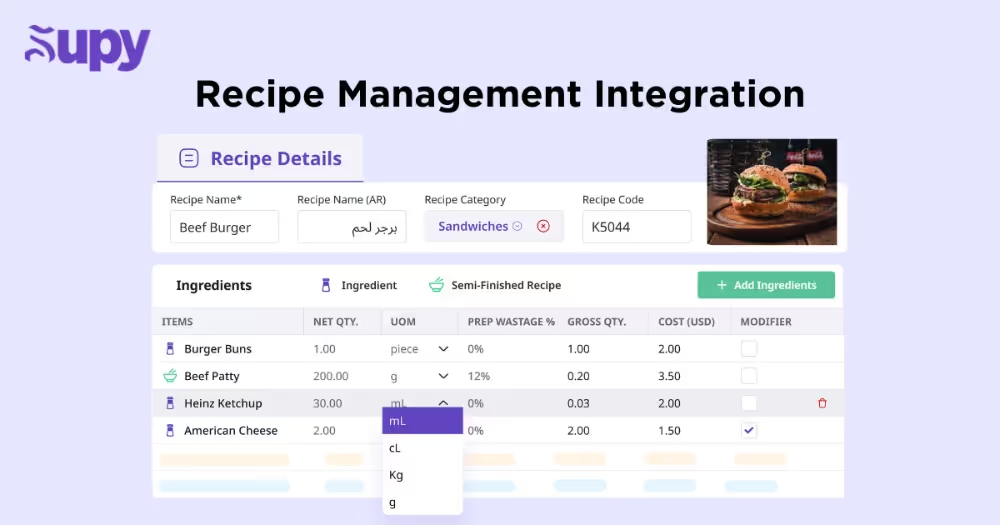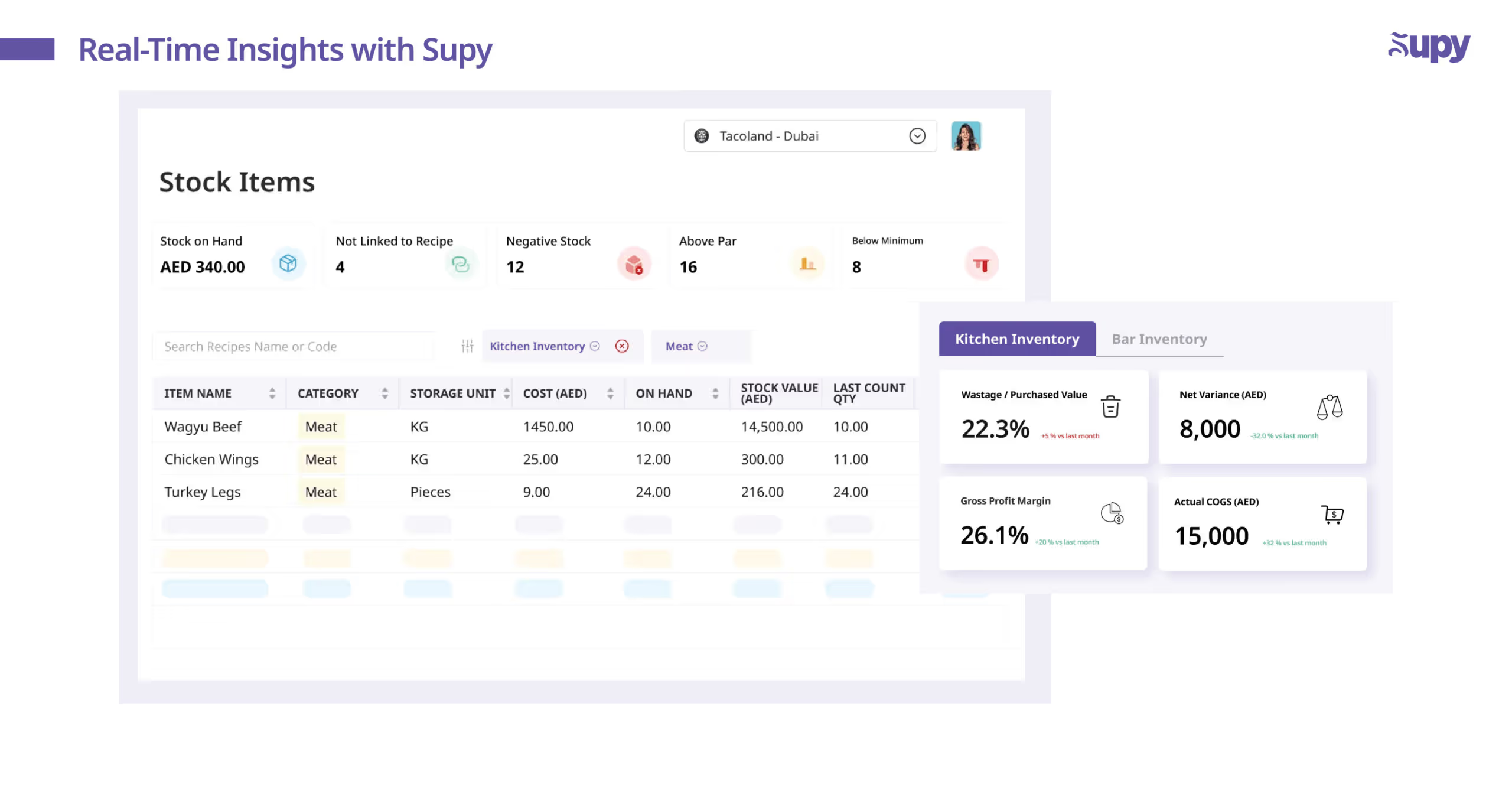Boosting Operational Efficiency with Automated Inventory Tracking in Restaurants

How much time does your team spend counting stock, double-checking numbers, or tracking down missing ingredients, only for those numbers to be outdated by the time they’re done?
A busy shift, a sudden rush, or a simple miscount can throw everything off. The result? Unexpected shortages, unnecessary waste, and higher costs. Yet, many restaurants still rely on manual inventory tracking using excel formulas, a process that takes up valuable time and leaves too much room for error.
This is where automation changes the equation. With real-time tracking, managers no longer need to second-guess stock levels or waste hours on manual counts. Automated inventory management systems provide accurate data instantly, helping restaurants cut waste, control costs, and free up time for what really matters, running a smooth, profitable operation.
In this blog, we’ll break down how automated inventory tracking improves restaurant operations, we'll cover:
- What is Automated Inventory Tracking?
- Efficiency Gains – Save Time on Inventory Tasks
- Improved Accuracy – Eliminate Human Error
- Real-Time Insights - Quick Decisions
- Improved Operational Processes – Better Customer Experiences
- Staff Productivity and Accountability
- Overcoming Implementation Worries
- Case Study: How Automatic Cut Food Costs by 20% with Automated Inventory Tracking
- Conclusion – Efficiency as a Competitive Advantage
- About Supy
1. What is Automated Inventory Tracking?
Think of automated inventory tracking as having a real-time stock assistant that keeps tabs on every item in your restaurant, without you having to manually count, update spreadsheets, or chase down missing ingredients. It uses software, barcode scanners, and even smart sensors (IoT devices) to monitor inventory levels automatically.

Here’s how it works:
- Inventory Management Software: Acts as the central hub, storing and updating stock data. Whenever ingredients are used in the kitchen or new supplies arrive, the system updates automatically.
- Barcode Scanners & RFID: Instead of manually logging stock, staff can scan items upon delivery or before using them. This instantly updates inventory records, reducing the risk of human error.
- IoT Sensors: Some advanced setups include weight sensors or smart shelves that detect when stock levels drop, alerting managers before they run out.
- POS Integration: When a dish is sold, the system automatically deducts the ingredients from stock, providing a real-time view of what’s left.
This seamless process keeps restaurants in control, preventing last-minute shortages and cutting down on wasted stock. With automation, inventory becomes a source of insight, not a daily headache.
2. Efficiency Gains – Save Time on Inventory Tasks
Inventory management is one of the most time-consuming tasks in a restaurant. A full stock count can take hours, and manual tracking often leads to outdated numbers due to last-minute sales or kitchen usage. Automation removes this guesswork by updating stock levels as items are received, used, or sold.
Here is how you can cut inventory time dramatically with automation:
- Receiving deliveries faster. Instead of manually checking invoices and writing down stock, your team can scan barcodes or QR codes to log items instantly. The system flags any missing or incorrect quantities, so you can spot issues immediately.
- Keeping stock levels accurate. Every time a dish is sold or an ingredient is used, the system automatically adjusts your inventory. No more spreadsheets or manual tracking.
- Ordering with precision. Instead of guessing what to reorder, the system tracks usage patterns and suggests order quantities, helping you avoid overstocking or running out of key ingredients.
- Using rolling counts instead of full stocktakes. Instead of shutting down operations for an hours-long stock check, your team can conduct quick rolling counts via a mobile app throughout the week to keep inventory up to date.
A restaurant that typically spends eight hours a week on food inventory management can reduce that to two hours with automation. That is six hours saved every week, time that can be spent on training staff, improving service, or reducing sitting inventory that ties up cash flow.
3. Improved Accuracy – Eliminate Human Error

Manual inventory tracking is prone to mistakes. A simple miscount, typo, or missed update can throw stock levels off, leading to shortages, waste, or unnecessary reorders. In a fast-paced restaurant environment, these errors add up quickly.
Research shows that the average human error rate in restaurant inventory management software is around 5%. That may not sound like much, but for a single restaurant, it can mean hundreds or even thousands lost every month due to misrecorded stock, over-ordering, or missing ingredients that disrupt service.
Automation removes many of these failure points:
- Barcode and QR scanning prevent miscounts by recording the exact item and quantity upon delivery.
- Real-time tracking updates inventory automatically as ingredients are used, so nothing gets missed.
- System-generated order lists reduce the risk of overstocking or under-ordering, ensuring only what is needed is purchased.
With fewer errors, restaurants spend less time fixing discrepancies and more time focusing on accurate inventory counts and smarter purchase orders. This leads to better forecasting, less waste, and stronger profit margins.
4. Real-Time Insights - Quick Decisions
Running a restaurant requires fast, informed decision-making. When inventory data is outdated, restaurant managers often realize too late that a critical ingredient is missing. The old way of managing stock meant waiting until a weekly count to uncover shortages, leading to last-minute orders, higher food costs, and service disruptions.

Automated inventory tracking provides real-time visibility, allowing restaurant owners to check stock levels anytime from their phone or computer. This means they can:
- Spot shortages before they cause problems. If a key ingredient is running low, a manager can reorder immediately or transfer stock from various restaurant locations, preventing delays.
- Adjust purchases based on real demand. Instead of relying on estimates, real-time data provides exact restock quantities, reducing inventory variance and excess spending.
- Monitor trends and refine costs. Advanced analytics offer detailed reporting, helping managers track goods sold, optimize food costs, and make smarter menu adjustments.
A connected inventory system with a point-of-sale (POS) system makes sure every sale instantly updates stock levels, keeping records accurate. Automated inventory reports highlight usage trends and discrepancies, allowing managers to make proactive decisions rather than reacting to stock issues.
Restaurants that use analytics have seen a 5 to 10 percent revenue boost and up to 20 percent improvement in EBITDA. Better insights lead to lower costs, improved margins, and smoother operations.
5. Improved Operational Processes – Better Customer Experiences
Automation improves back-of-house efficiency, reducing stock issues and delays that impact service quality. When inventory is well-managed, orders move faster, food stays consistent, and customer satisfaction improves.
- Smarter ordering and purchasing. A restaurant that frequently runs out of fresh seafood can set automatic reorder alerts to avoid shortages. Preventing stockouts reduces lost sales and emergency supply costs while ensuring a reliable menu for guests.
- More accurate prep and production. With real-time inventory data, kitchen teams generate precise daily prep lists based on demand. This helps reduce food waste, prevents over-prepping, and ensures key ingredients don’t run out mid-service.
- Better multi-location coordination. A centralized system eliminates the need to call individual locations to check stock. Managers can see inventory levels across all outlets, making it easier to transfer stock instead of overordering.
- Faster, smoother service. When ingredients are always available and prep is efficient, the front-of-house team avoids delays and last-minute menu changes. A restaurant that consistently delivers the right meals on time can see up to a 20 percent increase in repeat business, reinforcing customer satisfaction.
6. Staff Productivity and Accountability
Manual inventory tracking takes time away from tasks that improve service and food quality. Instead of spending hours counting stock and updating spreadsheets, staff can focus on preparing better meals and improving customer experience. Automating inventory shifts attention from tedious data entry to more valuable work.
- Less time on low-value tasks. Staff can manage inventory in seconds using barcode scanners, freeing up hours each week for kitchen prep, training, or service improvements.
- Improved accountability. A restaurant inventory management system tracks every stock movement, making staff more likely to follow standard operating procedures as discrepancies are flagged.
- Reduced theft and loss. Restaurants lose 3-4 percent of sales to theft, mostly from employees. Real-time tracking and alerts help prevent shrinkage by identifying unusual patterns early.
- Better team collaboration. Staff can check stock levels instantly instead of interrupting managers, making vendor management and ordering more efficient.
More accurate recipe management. With automated tracking, ingredient usage updates in real time, ensuring recipes are followed correctly and preventing inconsistencies.
7. Overcoming Implementation Worries
Switching to an automated inventory system may seem like a big change, but modern platforms like Supy are built for easy adoption. Even staff with little tech experience can start using the system effectively with minimal training.
- Simple mobile app. Instead of manually logging stock, staff can scan barcodes or enter stock counts in seconds. This keeps records accurate while reducing inventory costs linked to errors and miscounts.
- Seamless POS integration. Inventory updates automatically with every sale, eliminating manual adjustments. This improves real-time accuracy and helps restaurants save money by avoiding unnecessary overordering.
Minimal training is required. Supy’s intuitive dashboard simplifies tracking, allowing staff to follow workflows with ease. Guided onboarding allows quick setup without long training sessions.
https://www.youtube.com/watch?v=G8sXarpEjJA
With Supy, restaurants maximize profitability by reducing waste, streamlining operations, and improving inventory control, all without slowing down daily service. Talk to our expert!
8. Case Study: How Automatic Cut Food Costs by 20% with Automated Inventory Tracking
Automatic, a popular Lebanese restaurant in Muscat, Oman, struggled with tracking real stock consumption. Their existing systems relied on purchase records rather than actual usage, making it difficult to detect waste, theft, or discrepancies.
Inventory checks were inconsistent across staff, and counting inventory was time-consuming and prone to errors. Their previous solution, Apicbase, was too complex and unreliable on mobile, leading to inaccurate reporting and inefficiencies in daily operations.
By switching to Supy’s inventory software, Automatic gained real-time control over stock levels, helping staff track usage accurately across different kitchen sections. All the data on stock movement, food costs, and waste became instantly accessible, allowing managers to spot and fix discrepancies early.
With automated tracking, they optimized menu items, reduced food costs by 20%, and saved 100 hours per month. The result was smoother operations, better cost control, and more satisfied customers with a consistently stocked and well-managed kitchen.
9. Conclusion – Efficiency as a Competitive Advantage
Automating inventory tracking is more than just saving time. In the restaurant industry, efficiency directly impacts profitability. Restaurants that track inventory in real-time cut costs, reduce errors, and react faster to stock changes, giving them an edge over competitors still relying on manual processes.
With fewer stock discrepancies and better forecasting, managers can focus on menu innovation, staff training, or enhancing the guest experience instead of dealing with shortages and last-minute orders. Automation also helps minimize food waste, keeping costs low and operations running smoothly.
10. About Supy
Supy is an all-in-one inventory management platform that helps restaurants track stock in real time, reduce waste, and control costs. Automated tracking replaces manual stock counts, while smart purchasing tools ensure ingredients are always available without overordering. With full visibility into inventory, restaurants can make faster, data-driven decisions and streamline operations.
Discover how Supy’s automated solutions can make inventory management easier and more efficient for your restaurant. Request a demo today!






